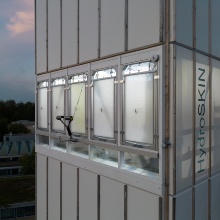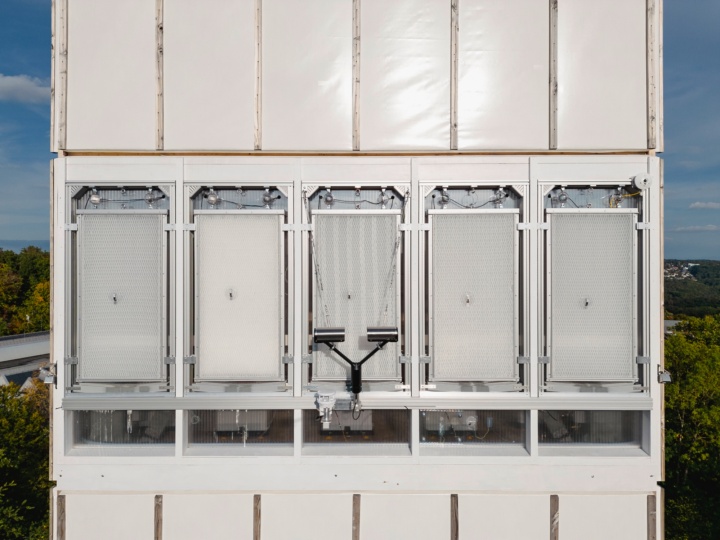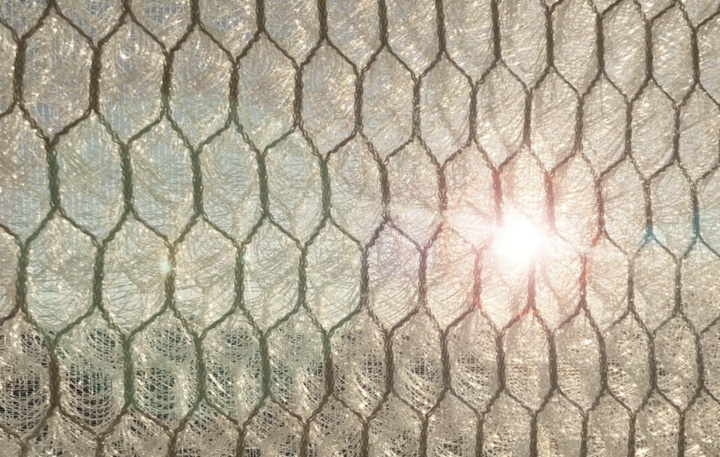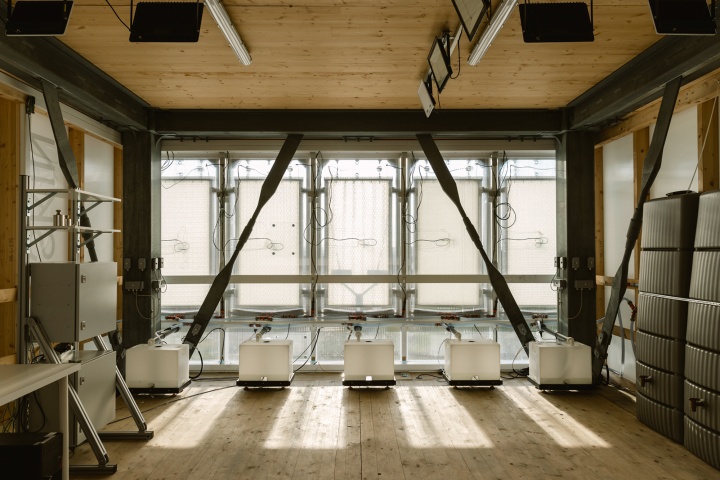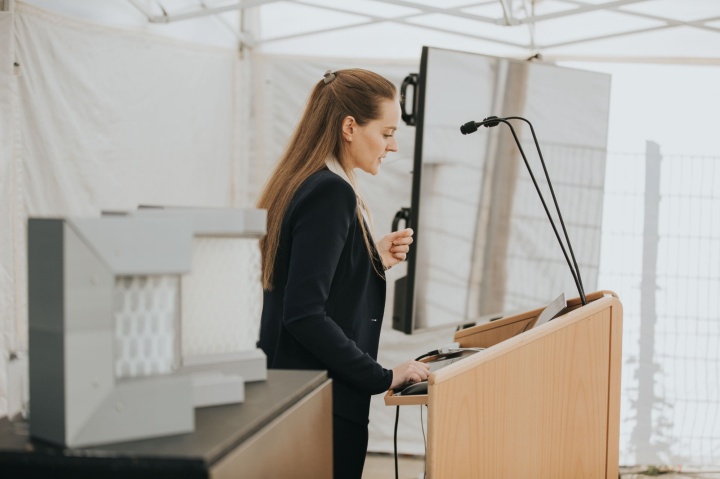The glass facade of a high-rise building can get so hot that you can fry eggs on it – a major factor in the overheating of our cities. At the same time, flood events such as torrential monsoon rains cause billions of dollars of damage annually. On October 4, 2022, a solution to both problems was presented at the University of Stuttgart: A hydroactive facade that cools down not only the exterior walls and the interior of a building, but also the urban spaces. For this purpose, textile facade elements called “HydroSKIN” absorb water while it is raining and release it again on hot days for evaporative cooling.
The aerial view of the metropolis of Singapore, taken with a thermal imaging camera, shows many orange-red spots and only one green-blue spot. The red zones represent built-up areas. In these areas, the temperatures are about 10 degrees higher than in the “green” parks. The reason is that about 60 percent of rainwater that rains down on natural surfaces evaporates and thus provides cooling. Sealed road and building surfaces, by contrast, allow only 10 percent of water evaporation. The other 90 percent ends up in the sewage system, leading to another worldwide problem: devastating flooding caused by heavy rain. Growing urbanization, compact urban development, and increasing land sealing are – in addition to the impacts of climate change – increasing the risks posed to our cities by heat and flooding.
Upgrading the sewage system in order to control the ever-increasing water masses would require an enormous construction effort. Moreover, in times of scarce resources, this is not a good solution, says Prof. Werner Sobek, Head of the Institute of Lightweight Structures and Conceptual Design (ILEK) at the University of Stuttgart until 2020 and former spokesperson of the Collaborative Research Center 1244 Adaptive Skins and Structures for the Built Environment of Tomorrow: “By contrast and with a minimal use of resources, hydroactive elements are an effective facade solution for neutralizing the urban heat island effect.”
A high rate of air circulation facilitates evaporation
The core element of HydroSKIN is a so-called spacer fabric, which consists of two textile layers that are kept apart by threads and so are well ventilated. The high rate of air circulation facilitates the evaporation of water and enhances the cooling effect of the facade. On the outside, the spacer fabric is surrounded by a water-permeable textile cover, which allows almost all raindrops to penetrate and at the same time protects the fabric from impurities. A film on the inside drains the water into the lower thread system. From there, it can either be stored in a reservoir or, when used directly in the building, help reduce water consumption. On hot days, the water can be returned to the facade element, where it evaporates and thus provides a natural cooling effect. “This facade system is an artificial surface for rainwater retention and evaporation in the building facade. It’s not only incredibly beautiful due to its visual and tactile qualities, it’s also a milestone in the adaptation of the built environment to the urgent challenges of our time,” explains Christina Eisenbarth, Research Assistant at the ILEK and inventor of HydroSKIN.
Great potential in the facades of high-rise buildings
High-rise buildings show great potential for the application of hydroactive facades – and not only because of their large facade surfaces. For one thing, with increasing height, the rain hits the facade at an angle as driving rain, so that, from a building height of about 30 meters, more rain can be absorbed by the facade than by a roof surface of the same size. For another thing, the high wind speeds increase the evaporative-cooling effect and a cool air flow is created that moves downward into the urban space.
The first HydroSKIN elements are currently being tested on the world’s first adaptive high-rise building on the Vaihingen Campus at the University of Stuttgart. The adaptive high-rise building is the flagship of the Collaborative Research Center 1244 and one of the projects selected for the International Building Exhibition (IBA). “The results are promising. In laboratory tests, we were able to demonstrate a temperature reduction of about 10 degrees due to the effect of evaporation. Initial measurements on the high-rise building from early September suggest that the cooling potential is even significantly higher,” explains Christina Eisenbarth.
“In 2023, another floor of the adaptive high-rise building D1244 will be realized with HydroSKIN elements. Gradually, each floor of the building will be equipped with newly developed and innovative facades that will contribute to greater resource efficiency and climate protection,” says Prof. Lucio Blandini, who is the Head of the ILEK, the person responsible for the planning of D1244, and the Deputy Spokesperson of the Collaborative Research Center 1244.
However, the use of hydroactive facade elements will not be limited to the demonstrator high-rise: Since HydroSKIN elements are very lightweight, they can be retrofitted to any facade on both new and existing buildings.
Festive event on the Vaihingen Campus
HydroSKIN was presented on October 4, 2022, within the framework of a festive event that was attended by the Vice Rector for Research and Early Career Researchers at the University of Stuttgart, Prof. Manfred Bischoff, the founder of the Collaborative Research Center 1244, Prof. Werner Sobek, the Spokesperson of the Collaborative Research Center 1244 and Head of the Institute for System Dynamics (ISYS), Prof. Oliver Sawodny, the Deputy Spokesperson of the Collaborative Research Center 1244 and Head of the Institute of Lightweight Structures and Conceptual Design (ILEK), Prof. Lucio Blandini, and another 50 participants from science, business, and politics.
Expert Contact:
Christina Eisenbarth, Universität Stuttgart, Institute of Lightweight Structures and Conceptual Design, phone: +49 (0)711 685-66138, E-Mail
Dr. Walter Haase, Universität Stuttgart, Institute of Lightweight Structures and Conceptual Design, phone: +49 (0)711 685-68310, E-Mail
Publikation: Potentials of hydroactive lightweight façades for urban climate resilience, Christina Eisenbarth, Walter Haase, Lucio Blandini, Werner Sobek, Wiley Online Library, März 2022, https://onlinelibrary.wiley.com/doi/full/10.1002/cend.202200003


